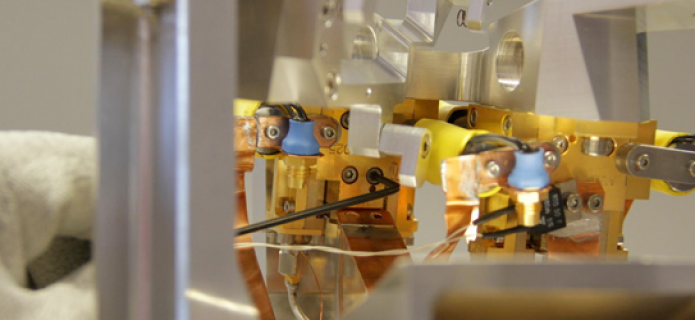ALMA opens new windows to exploring the Universe
An important step has recently been taken in Chile towards integrating the ten bands to be used by ALMA in each of the receivers on the array's 66 antennas.
The ten bands will make it possible to study radio waves from some of the oldest galaxies in the Universe and help us determine when some of the first stars formed.
The receivers in which the bands are installed were manufactured at Front End Integration Centers located in the United Kingdom, the United States and Taiwan. However, today most of the ALMA antennas still have fewer than half of the 10 definitive bands (bands 3,6, 7 and 9) and the aforementioned Integration Centers have closed their doors.
Given this situation, equipment was brought to Chile from some of the Integration Centers and ALMA engineers received training in the United States and Taiwan in these production lines. In March, operations began with the two Front End Test and Measurement Systems (FETMS).
With these FETMS, the missing bands can be integrated and checked in Chile. "We created a factory for integrating bands 4, 8 and 10—which were made in Japan—to add them to the receivers that still don't have them," said Bernhard López, System Integration Manager.
For electronic engineer Pablo Zorzi, supervising the integration of the new bands "is a very challenging and complex task, in which overcoming each obstacle depends on many factors." Today, López and Zorzi are satisfied with the results achieved, but a great deal of work remains because 64 more Front Ends have yet to be processed. The three additional bands are expected to be installed on all of the antennas by September 14, at which time 7 of the 10 definitive bands will be complete.
Once it is fully operational, ALMA will have 66 antennas that function as a single telescope. Thanks to a veritable arsenal of detectors—similar to highly sensitive radio wave receivers operating in different wavelength bands—the observatory will scrutinize the Universe at extremely short radio wavelengths of approximately one millimeter or less. These receivers have to be maintained at a temperature of -269 degrees Celsius in order to detect signals from space.
More Information
Announcement of the design and construction of a new group of receivers
Announcement: "ALMA is being equipped with detectors to perceive the signals from the Universe"
The Atacama Large Millimeter/submillimeter Array (ALMA), an international astronomy facility, is a partnership of Europe, North America and East Asia in cooperation with the Republic of Chile. ALMA is funded in Europe by the European Southern Observatory (ESO), in North America by the U.S. National Science Foundation (NSF) in cooperation with the National Research Council of Canada (NRC) and the National Science Council of Taiwan (NSC) and in East Asia by the National Institutes of Natural Sciences (NINS) of Japan in cooperation with the Academia Sinica (AS) in Taiwan. ALMA construction and operations are led on behalf of Europe by ESO, on behalf of North America by the National Radio Astronomy Observatory (NRAO), which is managed by Associated Universities, Inc. (AUI) and on behalf of East Asia by the National Astronomical Observatory of Japan (NAOJ). The Joint ALMA Observatory (JAO) provides the unified leadership and management of the construction, commissioning and operation of ALMA.
Contact:
Valeria Foncea
Education and Public Outreach Officer
Joint ALMA Observatory
Santiago, Chile
Tel: +56 2 2467 6258
Cell: +56 9 7587 1963
E-mail: [email protected]
